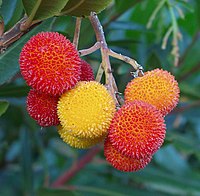
Photo from wikipedia
Inonotus obliquus grows in the Northern Hemisphere on some living broadleaved tree species as a pathogen, causing stem rot. In Estonia, the fungus is well known in the Betula species… Click to show full abstract
Inonotus obliquus grows in the Northern Hemisphere on some living broadleaved tree species as a pathogen, causing stem rot. In Estonia, the fungus is well known in the Betula species but can also be found on Alnus. Sterile conks of I. obliquus contain different bioactive compounds, but the quantitative and comparative research of these compounds in conks on different host species is limited. In the current work, I. obliquus was isolated and, evidently, determined from Alnus incana (L.) Moench., Alnus glutinosa (L.) Gaertn., and Betula pendula Roth, and the content of bioactive compounds in conks on these hosts were analysed. All the analysed conks sampled from A. incana and B. pendula contained betulin that varied from 111 to 159 µg/g. A significantly (p < 0.05) higher betulinic acid content was found in conks sampled from A. incana when compared with B. pendula: 474–635 and 20–132 µg/g, respectively. However, the conks from Betula were richer in total polyphenols, flavonols, and glucans. The content of inotodiol was quite similar in the conks from A. incana (7455–8961 µg/g) and B. pendula (7881–9057 µg/g). Also, no significant differences in the lanosterol content were found between the samples from these two tree species. To the best of our knowledge, this study is the first investigation of the chemical composition of I. obliquus parasitizing on Alnus. The results demonstrate that the bioactive compounds are promising in conks of I. obliquus growing not only on Betula but also on the Alnus species. It supports the opportunity to cultivate I. obliquus, also on the Alnus species, thus increasing the economic value of growing this tree species in forestry.
Journal Title: Biomolecules
Year Published: 2022
Link to full text (if available)
Share on Social Media: Sign Up to like & get
recommendations!